As a piano technician and music store owner, I get calls, emails, and messages on a weekly basis asking about what to do with an old piano. It’s a very common question. There are a wide variety of scenarios when it comes to older pianos, but the common denominator with folks contacting me, is that they don’t want it anymore and they’re hoping that I have all of the answers.
The good news, is that I have answers. The bad news, is that those answers may not be the ones they want to hear.
Can you sell it?
The bottom line, is that pianos do not last forever. Let me repeat that. Pianos do not last forever. They have a shelf life before they’re either done or they need restoration/reconditioning. So, how do you know if your piano has any monetary value, and if it does, how much? Any piano over 50-60 years old, is old. However, there are pianos that are 70 years old that are in excellent condition, because they were tuned annually, action parts were regulated and repaired over the years, hammers were filed, and the interior was cleaned here and there. Then, there are 50 year old pianos that were cheaply made (I’m talking to you, Kimball Artist Console), have been tuned once in 30 years, have mold and caked on dust, have signs of sitting in an excessively humid environment, and maybe was home to a mouse or two. What I’m trying to illustrate is that there are a lot of variables when it comes to determining how much monetary value your piano has, if any. It’s a safe bet to say if your piano has all original parts, has not been tuned regularly, is a run of the mill brand, and is over 70 years old, that it does not have any monetary value. Please, do not go off the exterior wood cabinet of the piano. When it comes to a piano’s value, the exterior matters very little. Those 100 year old, beautifully ornate, Victorian uprights are almost always super gross inside and are barely playable. They sure are pretty. But pretty does not a functional musical instrument make.
Examples of some super yuck pianos:
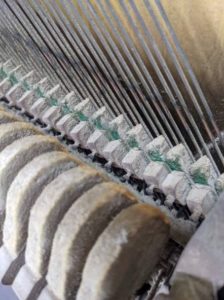
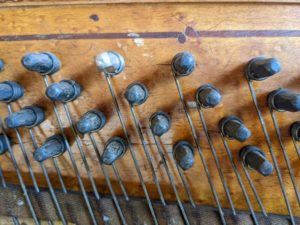
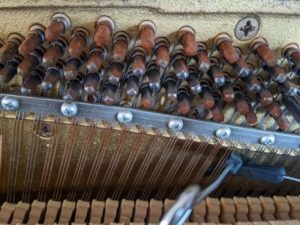

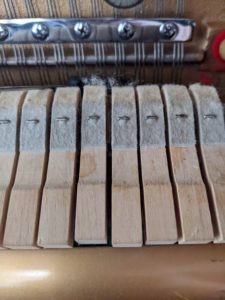
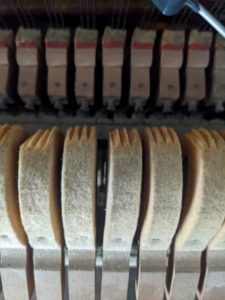
Well, what do I do with it, then?
This is where I have to give some tough love. If a piano has zero monetary value and it needs hundreds to thousands of dollars in work to make it functional, then the piano is past its playable life. This means that it shouldn’t be passed along to someone else, even if you’re giving it away for “free”. There are so many pianos just being passed around that are so far past their playable life and should really no longer be in circulation. Don’t get me wrong, I love pianos. My career is pianos. However, many are just not truly pianos anymore. They’ve become moldy, allergy-laden, pieces of furniture. Please don’t pawn something like that off onto someone else, because you don’t want to pay to have it moved.
If the piano has no monetary value, is not structurally sound (ie cracks in the pinblock and/or soundboard, bridge) and you’re not sentimentally attached to it, then the options are 1. Have it hauled away to the dump, or 2. Keep it where it is as a piece of furniture to put pictures and chochkies on.
Are those really the only options?! That’s so sad!! And do I have to pay to have it hauled away?!
Those are the easiest options, yes. And yes, it costs money to have a piano taken to a dump.
If you’re like me, you prefer not to add more bulk to our landfills. I get it. That’s why I encourage upcycling and I’m often hired by clients to upcycle their old pianos into other things. However, that takes either money or elbow grease and creativity. If you don’t want to go the upcycle route, you can keep some of the larger pieces out of the landfill by having a piano technician gut the piano for you (again, money), or do it yourself. Please, for the love, do not do it yourself without consulting a piano technician about how to safely do it. It’s very labor intensive and, frankly, it’s a little dangerous if you don’t understand how much string tension is being held and that those strings need to be loosened prior to removing them or you may lose an eye. Not kidding. That being said, if you know what you’re doing and are handy, you can salvage the wood from the exterior cabinet and the cast iron plate can be taken away as scrap metal and can be melted down. Sadly, everything else will still need to be thrown away, but at least some of the pieces, in particular the plate, aren’t taking up landfill space.
Thinking about upcycling? I have lots of projects that I’ve done for clients over the years. I only do upcycling on commission, for specific clients. I don’t take donations for upcycling and resale, just a heads up. Here are a few ideas to ponder: https://thepianogalshop.com/repurposed-pianos/
I’d like to finish up with this thought. The more that piano owners understand how pianos keep their value, the less pianos there will be that are not worth anything and are not servicable anymore. If you have a new piano, have it serviced regularly. If you have a used piano, have it serviced regularly. Then, they keep their value and don’t become a burden that’s stuck in your basement.
I say all of this with absolute love and passion for pianos.
